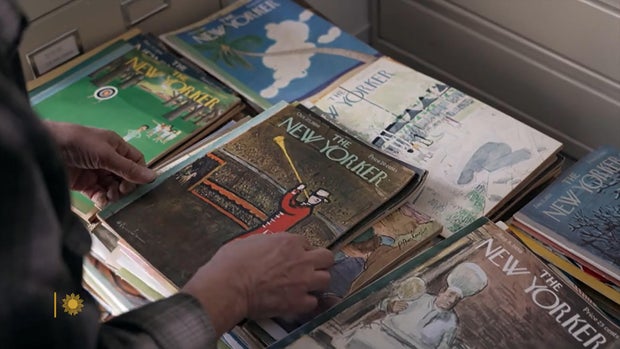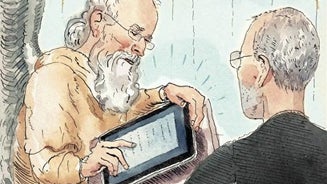The New Yorker magazine’s first hundred years

The New Yorker, the beloved weekly magazine, is celebrating its one-hundredth birthday. I have been a staff writer at the magazine since 2008, and Bruce Diones has been at The New Yorker since, well, not quite since the beginning. “1978,” he said. “I was in the cradle. They left me on the doorstep and I came.”
Asked his title, Diones replied , “I don’t really have one. I aid and abet all the crimes that happen here. I’m that guy that’s always around.”
“An expert on both the people and the magazine?”
“That’s right.”
“You can tell me what we published in 1979, but you can also tell me who’s mad at whom?”
“Yeah, and I can tell you why they’re mad at them and why that thing in ’79 didn’t work out!” he laughed.
CBS News
The New Yorker is known for its reporting, and for its idiosyncrasies. Each issue also includes cartoons, a short story, and a few poems. The front cover features not a photograph, but a painting.
One of Diones’ many responsibilities is to organize the magazine’s archive. “We have every magazine, every issue since the first one. We have scrapbooks, papers and all sorts of weird little ephemera from the people’s offices. It’s kind of fun, interesting stuff.”
The New Yorker may be America’s leading literary magazine, but its story starts with an artist: Rea Irvin. “All the artwork in The New Yorker is based on his work,” Diones said.
Irvin did the cover of the first issue published on February 21, 1925, of a fancy young man in a top hat, inspecting a butterfly. His name is Eustace Tilley, and he became the magazine’s mascot, for better or worse.
The New Yorker
“At long last, I’m gonna tell you that I’m ambivalent about Eustace Tilley,” said editor David Remnick. “Because some people look at it and they think it’s a symbol of snobbery, or overweening pride. When it began, it was meant to be a joke about snobbery.”
Remnick was a 39-year-old reporter when, in 1998, he was named the fifth editor of The New Yorker. His job is to keep the writers happy, and, as he sometimes reminds me, productive. His job is also to figure how, and how much, to modernize a 100-year-old magazine that once specialized in light-hearted articles about Manhattan society.
In that first issue of the magazine, founding editor Harold Ross wrote, “It is not edited for the old lady in Dubuque.”
I asked, “What did he have against Iowa?”
“I don’t know,” Remnick laughed. “To him, Dubuque included Queens, Los Angeles …”
The magazine’s reach, now, extends far past Manhattan. “We have more readers in the state of California than we do in the state of New York, including the old lady in Dubuque,” Remnick said. “It’s a magazine that has deep, deep reporting, and prides itself on accuracy and fact-checking.”
Fergus McIntosh leads the magazine’s battalion of fact-checkers – more than two dozen.
So, what is a fact-checker? “Somebody who takes a story submitted by someone like you and, before we publish it, makes sure that it is accurate, balanced, fair, and as complete as it can be,” McIntosh said.
“Fair? That seems like a hard thing to figure out,” I said.
“I know that’s hard for you. It’s not hard for us,” McIntosh laughed.
And everything gets checked – not just articles, but also poems, short stories, even cartoons. Teresa Matthews, the department’s associate director, once had to fact-check a cartoon about a penguin meeting his girlfriend’s parents. “He says, ‘We prefer the term Arctic-American,'” she recalled. “And this is factually incorrect, because penguins live in the Antarctic.”
“But Antarctic-American wouldn’t have been as funny,” I said.
“Not pithy enough, no,” said Matthews. “All of my emails to the wonderful cartoon editor about any potential issues I find, almost always I get a response of, ‘Thank you so much, Teresa. We will not be taking that change.'”
Somewhere along the way, The New Yorker became a serious magazine, publishing writers ranging from J.D. Salinger to James Baldwin, from the film critic Pauline Kael to the investigative journalist Ronan Farrow.
The New York Public Library will celebrate the magazine’s anniversary with an exhibition later this month.
So, what is The New Yorker in 2025? Remnick said, “It’s not just one thing. Sports illustrated was about one thing, and it’s easy to understand, for advertisers and readers. [The New Yorker] is a more complicated thing. It may be a little bit tricky to invite people in.”
“Is The New Yorker itself more political than it used to be?”
“I think it’s certainly more political than when it started out, that’s for damn sure,” said Remnick.
“Would it be wrong to describe The New Yorker as a liberal magazine?”
“No, I don’t think it would be wrong. I think there a wide range. I don’t think it’s an assertively ideological publication. I think reporting is at its center more than finger-wagging.”
These are anxious times for the media industry, and The New Yorker is not immune. The magazine had a round of layoffs in 2023. But The New Yorker has a steady base of around 1.2 million subscribers, many of whom read it on their phones. Remnick said, “How do we write shorter, faster things, as well as do the other things? In addition to; it’s not instead of. We have a pretty robust audio operation – four, five podcasts. We do video. But I’m thinking forward. I’m thinking about how do we have a New Yorker that has the possibility of celebrating 200 years? Because in American life, in the history of media, that’s unusual. Just ask the people who used to read Life magazine.”
For Bruce Diones, The New Yorker’s 100th birthday is a good excuse to revisit ancient history. He showed me a box left behind by a former employee named Fred Keefe: “He was a little guy like me with a bow tie, and he would sit in the corner and type out ‘letters to the editor’ answers.”
One letter was a request to visit the magazine’s offices. Keefe responded: “Thank you for your letter. We’re afraid there isn’t much to see in our offices. The editors and writers are all shut away in little cubicles and are very upset if people pop in on them.”
In fact, those old editors and writers and artists and cartoonists are still here, in spirit, and also in these boxes. The party’s been going for a hundred years, and new people are still being invited to join in.
I said, “maybe in another 100 years, someone will come and flip through whatever the newest version of that archives is?”
“That’s right, and I’m in it now,” laughed Diones. “And you’re in it, too. That’s kind of the thrill of it. You realize that, well, oh, this has always been going on, and we’re all a part of it.”
For more info:
- The New Yorker
- “A Century of Fiction in The New Yorker 1925-2025,” edited by Deborah Treisman (Knopf), in Hardcover, eBook and Audio formats, available February 25 via Amazon, Barnes & Noble and Bookshop.org
- “A Century of Poetry in The New Yorker 1925-2025,” edited by Kevin Young (Knopf), in Hardcover, eBook and Audio formats, available February 25 via Amazon, Barnes & Noble and Bookshop.org
- Exhibition: “A Century of The New Yorker,” beginning Feb. 25, at the New York Public Library, New York City
Story produced by Mary Raffalli. Editor: George Pozderec.
See also:
World News || Latest News || U.S. News
Source link





